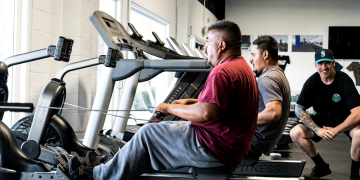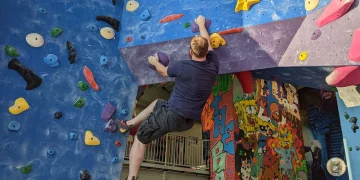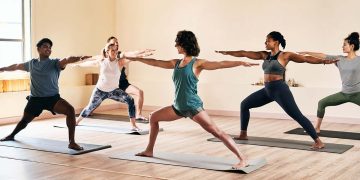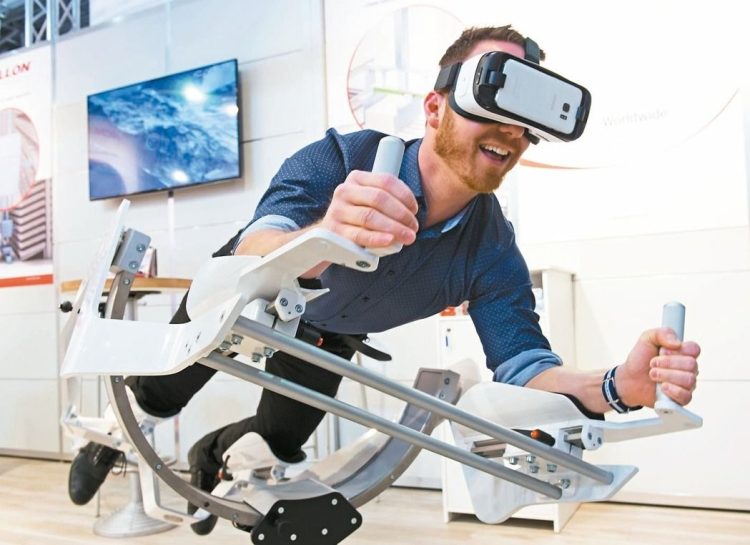Introduction
In the rapidly evolving world of fitness, new technologies are continuously pushing the boundaries of how we exercise. One such groundbreaking development is virtual reality (VR) fitness. Initially popularized by gaming, VR has quickly made its way into the fitness industry, offering immersive and engaging experiences that combine physical activity with virtual environments. But can VR fitness truly transform traditional workout routines and become a mainstream alternative?
In this article, we’ll explore how VR is changing the landscape of exercise, the physical and mental benefits it offers, and whether it has the potential to revolutionize the way we approach fitness.
1. What Is VR Fitness?
Virtual reality (VR) fitness is the integration of VR technology into workout routines, where users wear a VR headset to engage in interactive fitness activities in a virtual world. These workouts range from cardio exercises, strength training, and yoga, to more dynamic sports simulations like boxing, dancing, and even climbing—all within a fully immersive virtual environment.
Unlike traditional gym workouts or fitness classes, VR fitness offers a gamified, entertaining, and often immersive experience. The idea is to make exercise feel less like a chore and more like an exciting activity or adventure, all while providing real-time feedback and tracking of your performance.
Popular VR Fitness Apps and Games
Several VR platforms have emerged to make fitness more engaging, including:
- Beat Saber: A rhythm-based game where players slice through blocks in time with the music, providing a fun cardiovascular workout.
- BoxVR: A boxing workout game that allows users to punch, dodge, and block while following an instructor-led routine.
- Supernatural: A full-body workout game that offers a variety of cardio and strength workouts in stunning virtual locations.
- Holofit: A VR fitness app that turns exercises like rowing, cycling, and running into a virtual adventure, providing a range of scenic and interactive environments.
2. How Does VR Fitness Compare to Traditional Workouts?
Engagement and Motivation
One of the most significant advantages of VR fitness over traditional workouts is the high level of engagement it provides. In a typical gym setting, many people struggle with motivation, often finding traditional routines repetitive or uninspiring. On the other hand, VR fitness offers a dynamic, game-like experience where users can feel like they’re part of an exciting virtual adventure, whether they’re battling in a boxing ring or exploring a virtual landscape on a bike.
- Gamification: VR fitness integrates elements of gaming, such as levels, rewards, and achievements, making the experience more motivating and enjoyable. This gamification can make workouts feel less like a tedious task and more like a fun, interactive game.
- Personalization: Many VR fitness platforms allow users to customize their workouts based on their fitness level, preferences, and goals. Users can choose from a range of activities, track their progress, and set goals—all within the virtual environment.
- Reduced Boredom: The immersive nature of VR helps eliminate the boredom that many people experience during traditional exercises. Whether you’re dancing, boxing, or cycling, the virtual environments keep you engaged and distracted, allowing you to work out longer and more effectively.
Physical Intensity and Efficiency
When compared to traditional gym workouts, VR fitness can be just as physically demanding—if not more so—depending on the type of exercise. Games like BoxVR or Beat Saber involve fast-paced movements that elevate your heart rate and burn calories, while activities like Supernatural and Holofit combine cardio with strength training, offering full-body workouts.
- Cardio and Endurance: Many VR fitness games are designed to increase heart rate and improve cardiovascular health. Beat Saber, for instance, requires constant arm movements, which engage the upper body and help build endurance, while Supernatural incorporates full-body movements that keep the heart rate elevated for longer periods.
- Strength Training: Although VR fitness is primarily known for cardio-based activities, there are also VR workouts that target strength. For example, some VR platforms incorporate resistance training using virtual weights, bodyweight exercises, or other forms of strength-building routines.
- Flexibility and Balance: Some VR fitness apps are designed with yoga or Pilates-based movements that help users improve their flexibility, balance, and overall body awareness, similar to traditional fitness classes.
Tracking and Performance Metrics
Another significant advantage of VR fitness is the ability to track your performance in real time. Many VR apps offer detailed metrics that track calories burned, heart rate, number of reps, distance, and other key performance indicators (KPIs). This instant feedback helps users monitor their progress and make adjustments to their routines.
Unlike traditional workouts, where progress might be less immediate or visually obvious, VR provides tangible metrics that can keep users motivated. The ability to track workouts and see improvements over time is a strong motivator for many individuals, leading to greater consistency and better results.
3. Mental Health Benefits of VR Fitness
In addition to its physical benefits, VR fitness has a profound impact on mental health and well-being. Traditional workouts can sometimes feel monotonous or isolating, but VR workouts offer a unique mental escape, combining exercise with elements of entertainment, relaxation, and mindfulness.
- Stress Relief: The immersive nature of VR fitness can help users forget about the stresses of daily life. Engaging in a virtual environment while exercising allows individuals to mentally “disconnect” from real-world worries and focus on the task at hand, providing a form of stress relief and relaxation.
- Mood Enhancement: Similar to traditional exercise, VR fitness stimulates the release of endorphins, which are known to improve mood and promote a sense of well-being. The combination of fun, movement, and virtual environments creates a positive feedback loop, making people feel better both physically and emotionally.
- Mindfulness and Focus: Some VR fitness applications incorporate meditation and mindfulness elements, such as breathing exercises or virtual nature environments, that help improve mental clarity and focus. These aspects contribute to a more balanced mind-body connection, which is often lacking in conventional fitness routines.
- Social Interaction: Many VR fitness apps allow users to join group workouts, participate in challenges, or compete against friends in virtual environments. This social aspect can foster a sense of community, helping people stay motivated and connected even when working out at home.

4. Can VR Fitness Become a Mainstream Workout Routine?
The idea of VR fitness becoming a mainstream workout routine is intriguing, but there are several factors to consider. While VR offers a host of benefits, there are some challenges that may affect its widespread adoption.
Accessibility and Equipment Requirements
One of the main barriers to VR fitness is the cost and accessibility of the required equipment. VR headsets, which are necessary for a truly immersive experience, can be expensive, and not everyone has access to the space or the technology required to use them effectively. Additionally, VR setups require a stable internet connection, free space for movement, and sometimes additional accessories like controllers or sensors.
However, as technology continues to improve, it’s likely that the costs of VR systems will decrease, making them more accessible to the general public. Moreover, as VR becomes more mainstream in entertainment and gaming, more people will likely invest in VR systems for fitness.
Space and Safety Considerations
VR fitness requires sufficient space to move freely, which may not be feasible for everyone, particularly in smaller homes or apartments. Safety is also a concern; with users immersed in virtual worlds, there is the potential for injury if they become disoriented or move too quickly. However, many VR systems are incorporating safety features, such as virtual boundaries and real-time feedback to ensure users remain aware of their surroundings.
Hybrid Models and Integration
The future of VR fitness may not be about replacing traditional workouts entirely but rather offering a complementary option. Many people will likely continue to attend gyms, participate in outdoor activities, or engage in traditional fitness classes, while also incorporating VR workouts into their routines as a way to add variety, fun, and motivation.
A hybrid model, where users can alternate between VR fitness and traditional exercise, may be the most sustainable way for VR to become part of mainstream fitness culture. VR fitness can offer an engaging supplement to traditional training, keeping workouts fresh, fun, and motivating.
Conclusion
Virtual reality fitness has the potential to revolutionize the way we exercise. With its immersive environments, gamified experiences, and real-time performance tracking, VR fitness offers a unique and engaging alternative to traditional workouts. The physical and mental benefits, combined with its ability to make exercise more enjoyable and motivating, could help VR fitness become a mainstream workout trend in the coming years.
While there are challenges to widespread adoption—such as cost, space, and safety—VR technology is advancing rapidly, and the barriers to entry are likely to decrease over time. As VR becomes more accessible and integrated into our daily lives, it could transform not just the way we exercise but also how we think about fitness and well-being in general.
So, whether you’re looking for a fun new way to stay fit or you’re seeking a highly engaging workout routine, VR fitness might be the future you’ve been waiting for. Are you ready to step into the virtual world and break free from traditional exercise?

















































